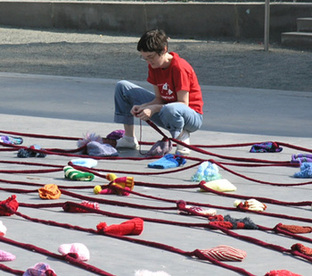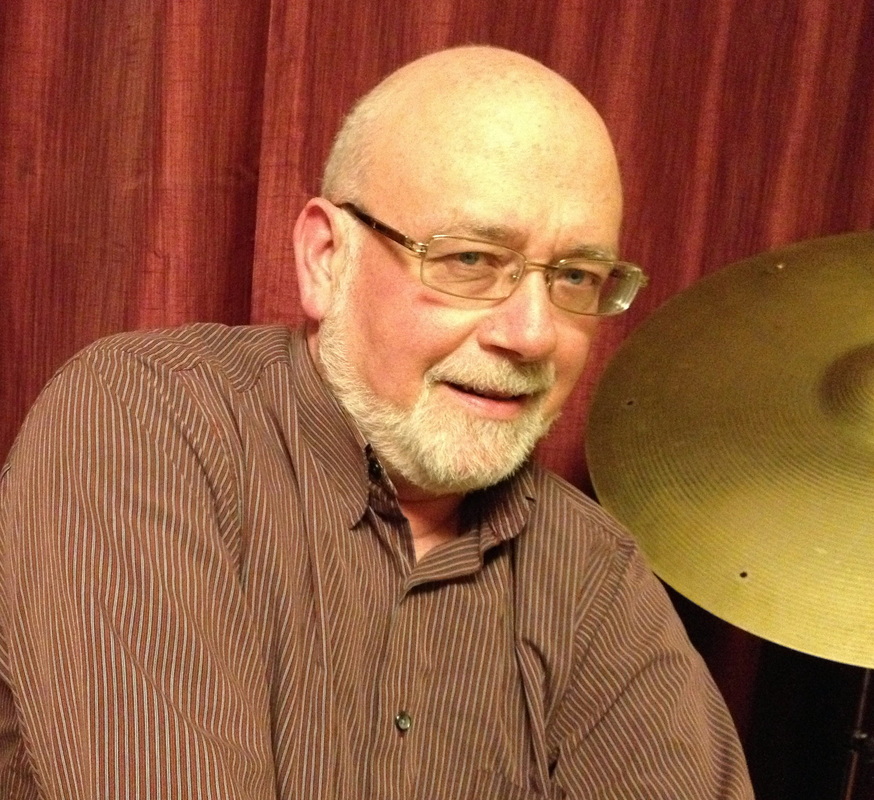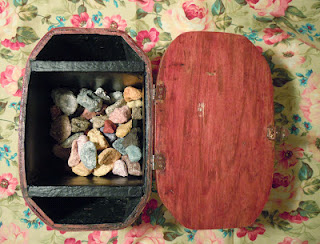- Hannah Brookman
Lindsay Obermeyer
 Photo by Samantha Bennett Why is art important? “I’m interested in seeing how the arts can reach out to communities that don't generally think of themselves as having access to the arts. I work in the community to create art as a way of trying to connect people together. Because often people don't talk to each other, the work that I do tends to break the ice. With The Red Thread Project, I physically connected them together.” Lindsay Obermeyer is a textile artist, currently living in St. Louis, Missouri. Her interest in textiles has brought her down many paths. She has published knitting patterns, sewn dance costumes, owned a yarn store, produced ‘craft as fine art’, and most notably, founded The Red Thread Project, a community based performance piece. The project started as a dare from a colleague to connect a university to a town. “I physically connected them together,” said Obermeyer. She hand-knit dozens of hats, and linked them with a knit cord then invited the public to wear them. The closeness and absurdity created by the situation fostered more than simply physical connection; as the troop of hat-bearers paraded through the town, they also created friendships. Obermeyer did the performance multiple times then brought the hats to a homeless shelter to teach the men to sew, before they disconnected the hats and got to keep them. “It kept growing. It was affective for a lot of people especially for kids, it was about character education, less about art. Because even trained art educators didn’t get what I was teaching about art. They didn’t understand that yarn is a pliable line, that when knitted creates a shape, that when bent creates form of mass that then can be worn, and it has color and texture. Basic elements of art here! But because they're trying to think of art as painting and drawing and sculpture, and textiles and craft, they couldn't make the connection. So I often came in as a character educator, teaching kids about their community; that even though they're in 4th grade, they have a voice and a connection to everybody around them and that they better darn well start paying attention.” | Though Lindsay has now retired The Red Thread Project, she has not stopped bringing her art into the community. She was recently commissioned by the chamber of commerce of St. Louis to do a performance piece to bring attention to an unpopular neighborhood. “We would roll out astro turf, and sit and knit in the parking space. It was a neighborhood that had a lot of gang activity, and here we were benignly knitting. So it was a political statement; like, ‘you know what, we can have this shit go around us, but were just going to knit.’ We had a lot of kids involved. It was a way of driving interest to a blighted area. I was using the arts to make a neighborhood more palatable. And I got paid to do that!” Lindsay was paid to create an enjoyable atmosphere in a neighborhood. This is because, “economically, art is a machine,” she explains. “Not that it trickles down to the artists often, but it does drive commerce.” Obermeyer gave me numerous examples of ways cities thrive through art. Paris is her favorite example, but she also recognizes the influence of the arts on Chicago. “When people talk about Chicago, they talk about the Bears and the Cubs, but they also talk about the Art Institute and the Sears tower. And thats art.” She mentioned St. Louis’ efforts to establish a larger arts community, as well as Paducah, Kentucky’s new flourishing art scene. Obermeyer sees that as art becomes more accessible, more people are attracted, and the economy grows. Lindsay has created a successful career as an artist. As she likes to say, she manages herself as a business, and makes sure she gets paid for her work. She is currently knitting almost 600 skeins of yarn for a 12 x 26 knit bomb piece for the Motorola offices, and will be presenting a paper on the relationship between textile arts and the medical arts at a textile conference in Nebraska at the Textile Society. “It’s not that hard. It just takes tenacity and a willingness to let go of preconceived notions of high art and low art, and fine art and fine craft, and just make.” - Lindsay Obermeyer To see more of Lindsay Obermeyer's work, visit her site at http://www.lbostudio.com/ |


 RSS Feed
RSS Feed
